
(To see the PPT.)
(1) We will try to know some basic information about epidemics in history.
Name of the epidemics Time Place Justininian's Plague (bubonic plague ) 500-550AD North Africa, the Middle East, Europe The Black Death 1330 Europe, Asia, Africa, the middle East The Great Flu Epidemic (The Spanish Flu) 1918 Similar as the Black Death SARS 2002/2003 China , Canada, Hong Kong,---
3. Read the text carefully and understand related science terms
In this text, a lot of medicine words are involved.
(1)To present question 3
What does the word "affect" mean in the 5th paragraph?
A 影响 B效果C感染D死亡
(2)Now read the text carefully and complete the sentences using medicine words in the text:
1. Bacteria and __________(病毒)have been around since the beginning of life on Earth.
2. It's important to look at the __________(传播)of diseases throughout history to discover the __________(原因)and __________(影响) of epidemics.
3. Another epidemic __________(开始) and __________(传播)in similar conditions was the Great Flu. It __________(侵袭)near the end of the first World War and __________(持续)after the war.
4. Doctors weren't sure how to __________(治疗)or __________(预防)it and since most people had no natural __________(防御)against the disease, it was harmful to doctors.
5. One half to one third of the population was __________(死于)to the Black Death. Less populated areas were less severely__________(感染).
6. SARS epidemic quickly __________(扩大)across the globe. Health experts worked together to __________(阻止)the virus in its __________(路径).
7. It __________(席卷)North Africa, the middle East and Europe.
(3)While doing these kind of exercise, explain some words such as "track".
-
相关教案下载
- 12019-2020学年北师大版高中英语选修7教案:Unit21 Lesson3 Epidemics Explained
- 2【优化设计】2018-2019学年北师大选修7高二教案:Unit21:Lesson 3 Epidemics Explained教学案
- 3【精品教案】2018-2019学年北师大选修7高二教案:Unit21 Lesson3 Epidemics Explained
- 42019-2020学年北师大版高中英语选修7教案:Unit21:The Language Points 教学案
- 52019-2020学年北师大版高中英语选修7教案:Unit21:Communication Workshop教学案
- 62019-2020学年北师大版高中英语选修7教案:Unit21:Human Biology教学案
- 72019-2020学年北师大版高中英语选修7教案:Unit21:Communication Workshop优秀教学案
- 82019-2020学年北师大版高中英语选修7教案:Unit21:Lesson 1Super Athletes教案1
- 92019学年度北师大版选修七Unit21 Human Biology Section Ⅲ Lesson 3 Epidemics Explained 学案设计(3页word版)